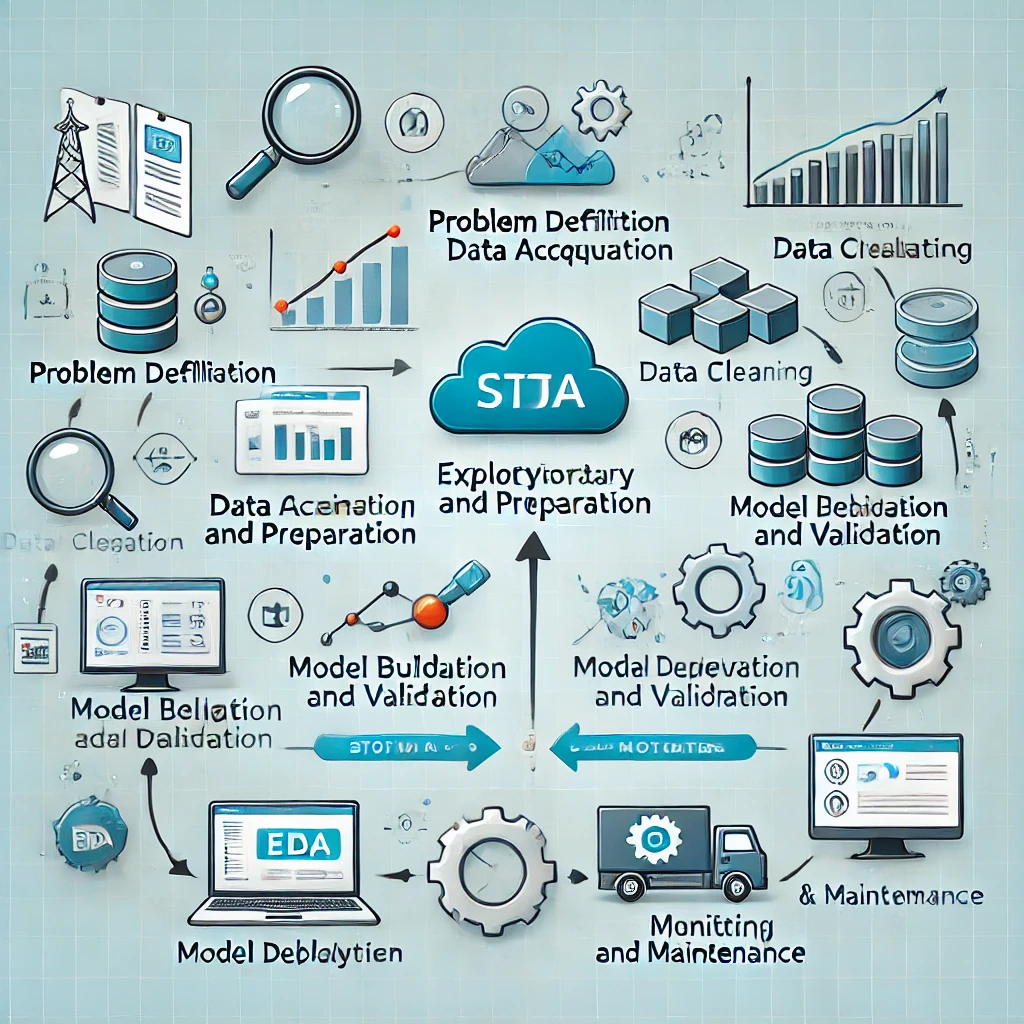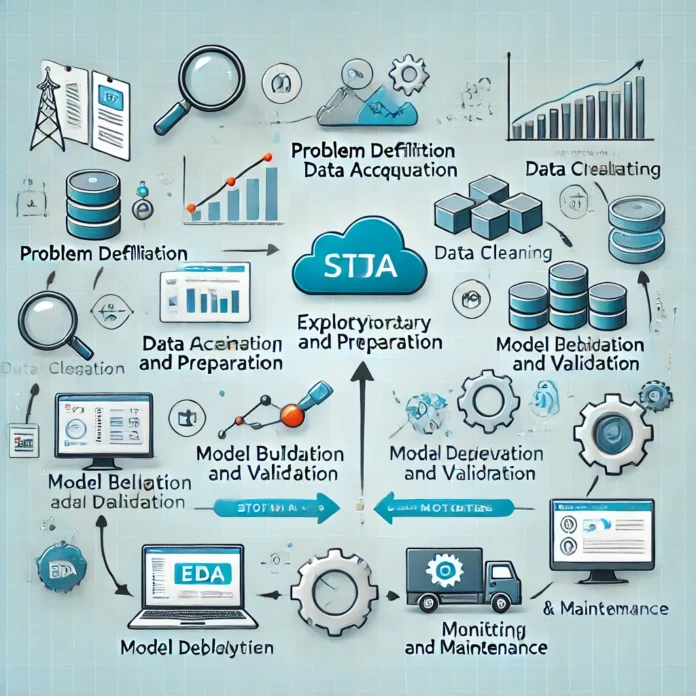Data science is revolutionizing industries across the globe, driving informed decision-making and enabling organizations to uncover valuable insights from data. Successfully developing and deploying data-driven solutions requires a structured, multi-step approach that involves data acquisition, model building, and effective deployment. This guide outlines the key stages involved in creating data-driven solutions, with practical examples and use cases to illustrate the process.
1. Problem Definition: Establishing the Objective
The first step in developing any data-driven solution is to clearly define the problem or business objective. This phase involves understanding what the organization aims to achieve with data science. Whether it’s improving customer retention, optimizing supply chains, or detecting fraud, the problem definition sets the direction for the entire project.
For instance, in a retail business, the objective might be to predict customer churn and implement strategies to retain at-risk customers. In healthcare, the goal could be to predict patient readmission rates to enhance patient care and reduce costs.
Key considerations during problem definition:
- Identify specific business challenges or opportunities.
- Determine the scope of the project (e.g., time frame, resources, stakeholders).
- Establish clear metrics for success (e.g., reduction in churn, cost savings).
2. Data Acquisition: Gathering Relevant Data
Once the problem is defined, the next step is data acquisition. Data can come from a variety of sources, including internal databases, external APIs, web scraping, and IoT devices. Data may be structured (e.g., tables, spreadsheets) or unstructured (e.g., text, images, videos), and the quality and quantity of data are critical for successful modeling.
For example, if the goal is to build a recommendation system for an e-commerce platform, the data may include customer purchase history, product ratings, and browsing behavior. Similarly, in a predictive maintenance scenario for manufacturing, sensor data from machines could be used to predict equipment failures.
Key considerations during data acquisition:
- Identify the relevant data sources and determine how to collect the data.
- Ensure data quality by assessing completeness, accuracy, and consistency.
- Secure access to data, ensuring compliance with regulations like GDPR.
3. Data Cleaning and Preparation: Preparing Data for Analysis
Raw data is rarely ready for analysis. The data cleaning and preparation phase involves transforming raw data into a structured format suitable for modeling. This process includes handling missing values, removing duplicates, correcting inconsistencies, and creating new features that may enhance model performance.
For instance, in a customer churn prediction project, data cleaning might involve addressing missing demographic information or correcting anomalies in transaction records. Additionally, feature engineering—creating new variables such as customer lifetime value or purchase frequency—can significantly improve the accuracy of predictive models.
Key considerations during data cleaning and preparation:
- Handle missing data using techniques like imputation or removal.
- Identify and remove outliers that could skew results.
- Perform feature engineering to create meaningful variables.
4. Exploratory Data Analysis (EDA): Uncovering Patterns and Insights
Exploratory Data Analysis (EDA) is a crucial step that helps data scientists understand the underlying structure of the data. EDA involves using statistical methods and visualization tools to identify trends, correlations, and patterns that may influence the model-building process. It also helps in validating assumptions and guiding feature selection.
For example, in an EDA of customer data, visualizations like histograms, scatter plots, and heatmaps can reveal which factors (e.g., frequency of purchases, customer service interactions) are correlated with churn. Understanding these relationships allows data scientists to focus on the most relevant features for modeling.
Key considerations during EDA:
- Use visualization tools like Matplotlib, Seaborn, or Power BI to explore data visually.
- Identify key variables that may affect the outcome.
- Test assumptions about data distribution and relationships.
5. Model Building: Selecting and Training Algorithms
Model building is at the core of data-driven solutions. This phase involves selecting appropriate machine learning algorithms based on the problem at hand and training the model using the cleaned and prepared data. Depending on the type of problem—whether it’s classification, regression, clustering, or recommendation—different algorithms may be more suitable.
For example, in fraud detection, supervised learning algorithms like random forests or gradient boosting may be used to classify transactions as fraudulent or legitimate. In contrast, unsupervised learning methods like K-means clustering might be used for customer segmentation.
Key considerations during model building:
- Choose algorithms based on the problem type (e.g., classification, regression, clustering).
- Split the data into training and test sets to evaluate model performance.
- Tune hyperparameters to optimize the model’s accuracy and robustness.
6. Model Evaluation and Validation: Ensuring Accuracy and Reliability
Before deploying a model, it is essential to evaluate and validate its performance. Model evaluation involves testing the model on a separate validation or test set to ensure that it generalizes well to new data. Metrics such as accuracy, precision, recall, F1 score, and AUC-ROC are commonly used to assess the performance of classification models, while metrics like RMSE (Root Mean Squared Error) are used for regression models.
For instance, in a healthcare application that predicts patient readmissions, evaluating the model’s precision and recall can help balance between catching potential readmissions and avoiding false positives.
Key considerations during model evaluation and validation:
- Use cross-validation techniques to prevent overfitting.
- Select evaluation metrics based on the problem (e.g., accuracy, precision, recall).
- Compare the performance of different models and select the best one.
7. Model Deployment: Implementing the Solution in Real-Time Environments
Deploying a data-driven solution means integrating the model into a real-time environment where it can deliver value. This phase involves setting up the necessary infrastructure, such as cloud-based platforms or APIs, and ensuring that the model can scale and perform efficiently under production conditions. Deployment may also involve creating user interfaces or dashboards to present the results to decision-makers.
For example, in a recommendation system for an online platform, deployment might involve integrating the model with the company’s website to provide real-time product recommendations to users. In fraud detection, the model might need to be deployed in a low-latency environment to flag fraudulent transactions instantaneously.
Key considerations during model deployment:
- Ensure scalability and performance in production environments.
- Set up monitoring systems to track the model’s performance over time.
- Automate retraining pipelines to update the model with new data.
8. Monitoring and Maintenance: Ensuring Continuous Improvement
Once deployed, data-driven solutions require ongoing monitoring and maintenance. This ensures that the model continues to perform as expected and adapts to changes in data patterns over time. Regular updates and retraining are often necessary to keep the model accurate.
For instance, in customer churn prediction, the model may need to be retrained as new customer behavior data becomes available. Continuous monitoring helps detect issues like model drift, where the model’s performance degrades over time due to changes in the underlying data.
Key considerations during monitoring and maintenance:
- Set up automated alerts for model performance degradation.
- Implement regular retraining processes with updated data.
- Continuously evaluate and refine the model based on feedback and new developments.
Conclusion: The Path to Data-Driven Success
Developing and deploying data-driven solutions is a complex but rewarding process that requires a combination of technical expertise, business understanding, and strategic thinking. From problem definition to ongoing maintenance, each step plays a crucial role in ensuring the success of data science projects. By following a structured approach, organizations can unlock the full potential of their data, driving innovation, efficiency, and competitive advantage.
Whether it’s improving customer experiences, optimizing operations, or enhancing decision-making, data-driven solutions have the power to transform businesses and create lasting value in today’s data-centric world.





